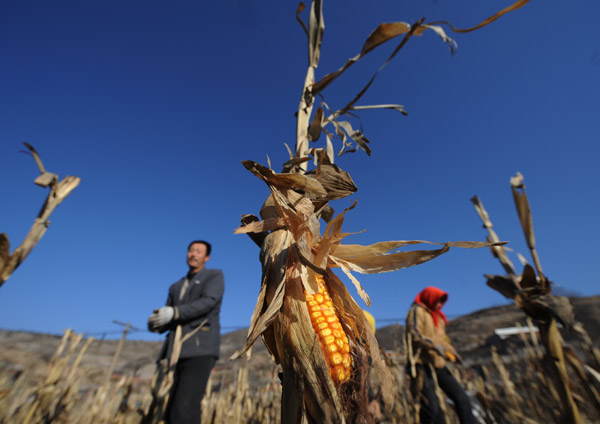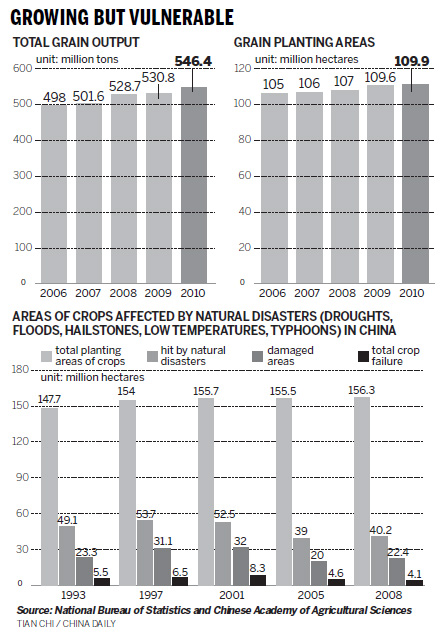Society
Risk looms despite good harvest
By Jin Zhu (China Daily)
Updated: 2010-12-28 07:38
 |
Large Medium Small |
BEIJING - Although the country's grain harvest achieved its seventh consecutive increase this year, the risk of decreased output looms, a leading official has warned.
 Farmers harvest corn from a field affected by the severe drought in Baimujing village, in Shanxi province's Pingding county, on Dec 17. The drought had affected 1.1 million hectares of farmland in the province by mid-December. [Photo/Xinhua] |
The country's grain output was 546 million tons this year, a sharp increase from 430 million tons in 2003, official figures show.
| ||||
Chen published a signed article in Caijing magazine in December, highlighting concerns that the country's agricultural production has been increasingly threatened by rapid industrialization and urbanization.
With 525 million tons of grain being consumed annually, the country still enjoys a "small" surplus of more than 21 million tons, the article said.
"But the supply-and-demand imbalance among regions is great," Chen said.
Domestic grain output from 13 major production areas in 2009 exceeded 397 million tons and accounted for 77 percent of the total, the article said.
In contrast, only 33.6 million tons of grain, or 6.5 percent of nationwide production, came from the seven most populous municipalities and provinces, including Beijing, Shanghai, Zhejiang and Guangdong - areas that consumed more than 97 million tons of grain.

"The amount of grain sent from the North to the South has increased greatly in recent years, as grain production capacity has severely declined in some southern coastal areas," Chinese Academy of Agricultural Sciences researcher Lu Bu said.
He echoed Chen's worries that the food security risk is growing, as most grain is produced in ecologically fragile northern areas.
"For instance, the country may encounter an output decrease next year, as some drought-affected areas are major winter wheat planting areas, such as Shanxi and Anhui provinces," he said.
Earlier this month, the Office of State Flood Control and Drought Relief Headquarters revealed a wheat planting area of 3.87 million hectares had been plagued by a drought caused by higher temperatures and water shortages along the Yellow and Huaihe rivers' floodplains.
The drought-affected area accounted for 19 percent of the country's winter wheat planting base.
In addition, the supply-and-demand balance for some grain varieties was increasing, Chen's article said.
China imported 42.6 million tons of soybeans in 2009, which was three times the nationwide output, or more than half of the world's soybean trade volume.
Soybean imports are estimated to reach 48 million tons this year.
"As more soybeans are imported, domestic prices may be greatly affected by the world market, leading to a series of price fluctuations among related agricultural products," Chen said in the article.
"There will not likely be a shortage of agricultural products next year, but price fluctuations will be an increasing public concern."
Lu said some southern provinces with rich water and land resources do not seek to expand agriculture, because they believe the sector does not generate significant economic returns.
"The central government needs to strengthen its supervision of local governments and monitor officials to ensure agricultural production," he said.



